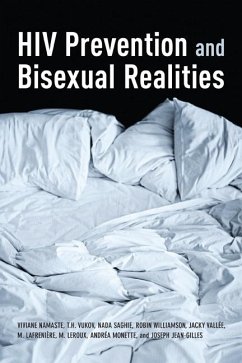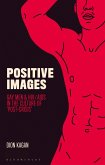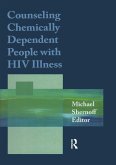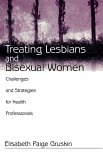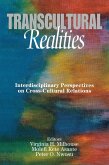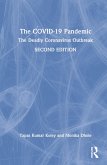Viviane Namaste, Tamara Vukov, Nada Saghie, Robin Williamson, Jacky Vallee, Mareva Lafreniére, Marie-Josée Leroux, Andre Monette, Joseph Jean Gilles
HIV Prevention and Bisexual Realities
Viviane Namaste, Tamara Vukov, Nada Saghie, Robin Williamson, Jacky Vallee, Mareva Lafreniére, Marie-Josée Leroux, Andre Monette, Joseph Jean Gilles
HIV Prevention and Bisexual Realities
- Gebundenes Buch
- Merkliste
- Auf die Merkliste
- Bewerten Bewerten
- Teilen
- Produkt teilen
- Produkterinnerung
- Produkterinnerung
Through interviews with a variety of bisexual men and women, HIV Prevention and Bisexual Realities uncovers innovative, important directions to consider for more effective HIV prevention strategies.
Andere Kunden interessierten sich auch für
![Positive Images Positive Images]() Dion KaganPositive Images40,99 €
Dion KaganPositive Images40,99 €![Counseling Chemically Dependent People with HIV Illness Counseling Chemically Dependent People with HIV Illness]() Michael ShernoffCounseling Chemically Dependent People with HIV Illness183,99 €
Michael ShernoffCounseling Chemically Dependent People with HIV Illness183,99 €![Treating Lesbians and Bisexual Women Treating Lesbians and Bisexual Women]() Elisabeth Paige GruskinTreating Lesbians and Bisexual Women162,99 €
Elisabeth Paige GruskinTreating Lesbians and Bisexual Women162,99 €![Transcultural Realities Transcultural Realities]() Virginia H. MilhouseTranscultural Realities162,99 €
Virginia H. MilhouseTranscultural Realities162,99 €![The COVID-19 Pandemic The COVID-19 Pandemic]() Tapas Kumar KoleyThe COVID-19 Pandemic180,99 €
Tapas Kumar KoleyThe COVID-19 Pandemic180,99 €![Beyond the Glass Ceiling: Navigating the Realities of Working Women Beyond the Glass Ceiling: Navigating the Realities of Working Women]() Ruby JindalBeyond the Glass Ceiling: Navigating the Realities of Working Women29,99 €
Ruby JindalBeyond the Glass Ceiling: Navigating the Realities of Working Women29,99 €![Bisexual Perspectives on the Life and Work of Alfred C. Kinsey Bisexual Perspectives on the Life and Work of Alfred C. Kinsey]() Bisexual Perspectives on the Life and Work of Alfred C. Kinsey202,99 €
Bisexual Perspectives on the Life and Work of Alfred C. Kinsey202,99 €-
-
-
Through interviews with a variety of bisexual men and women, HIV Prevention and Bisexual Realities uncovers innovative, important directions to consider for more effective HIV prevention strategies.
Hinweis: Dieser Artikel kann nur an eine deutsche Lieferadresse ausgeliefert werden.
Hinweis: Dieser Artikel kann nur an eine deutsche Lieferadresse ausgeliefert werden.
Produktdetails
- Produktdetails
- Verlag: University of Toronto Press
- Seitenzahl: 232
- Erscheinungstermin: 24. Januar 2013
- Englisch
- Abmessung: 231mm x 155mm x 20mm
- Gewicht: 476g
- ISBN-13: 9780802099938
- ISBN-10: 0802099939
- Artikelnr.: 34565011
- Herstellerkennzeichnung
- Libri GmbH
- Europaallee 1
- 36244 Bad Hersfeld
- 06621 890
- Verlag: University of Toronto Press
- Seitenzahl: 232
- Erscheinungstermin: 24. Januar 2013
- Englisch
- Abmessung: 231mm x 155mm x 20mm
- Gewicht: 476g
- ISBN-13: 9780802099938
- ISBN-10: 0802099939
- Artikelnr.: 34565011
- Herstellerkennzeichnung
- Libri GmbH
- Europaallee 1
- 36244 Bad Hersfeld
- 06621 890
By Viviane Namaste, T.H. Vukov, Nada Saghie, Robin Williamson, Jacky Vallée, M. Lafrenière, M. Leroux, Andréa Monette, and Joseph Jean-Gilles
Introduction
1. The Epistemology of Epidemiology: Understanding the Knowledge and
Limits of Public Health Research and Education
2. Epidemiology as informing social science research
3. Behaviour: limited as a basis for knowledge and education
4. Evidence-based medicine and HIV education
5. The cultural construction of epidemiological categories
6. Epidemiology and gender: Where are the women in public health?
7. Epidemiology and the erasure of bisexuality
8. Race and public health: Cultural stereotypes and epidemiological
research
1. Conclusion
2. Institutional Ethnography: Understanding the links between research, policy
and education on HIV/AIDS
3. Institutional ethnography
4. Institutional ethnography and research methods: how to collect data
5. A critical literature review
6. "Leading Together": HIV/AIDS policy in Canada and how it informs education
7. "Step up prevention efforts"
8. Funding HIV/AIDS research in Canada
9. "More information about the prevalence of bisexuality within the studied
population"
10. Whose community?
11. Specific Populations: The exclusion of bisexuality in federal AIDS funding
12. Conclusion
13. Methods and Methodology: Designing an HIV Prevention Research Project
Relevant to People who have Sexual Relations with both Men and Women
14. Interviews
15. Interview guide
16. Recruitment
17. Statistical overview of study respondents
18. Community-based research and action research
19. Conclusion
20. "The message is ugly, you know?" Limits of HIV Education in Québec
Information
21. Current HIV campaigns: Shooting ourselves in the foot ?
22. - "The message is ugly, you know?":
23. Beyond fear-based HIV campaigns
24. - Lack of information concerning both male and female partners in existing
campaigns
25. - Using plain language to get a message across
26. - Diversity of people in educational campaigns: age, culture, multiple
sexual partners, beauty
27. - The need for practical information
28. Suggested formats for HIV education
29. Conclusion
30. "Cherchez la femme": The exclusion of women in HIV education and services
31. Cherchez la femme
32. Content desired for inclusion in educational campaigns
33. Conclusion
34. "And that's a big gap, I think": Linking HIV/STD education and services
Linking education and services
35. Access to health care services for bisexual men and women
36. Swingers: access to condoms
37. "Et les filles?" The lack of sexual health information for bisexual women
38. Suggestions for linking education and services
39. Conclusion
40. Connecting knowledge and action: Development and distribution of HIV and
STD prevention materials
41. Actions during the research process
42. Development of educational posters
43. Conclusion
Conclusion
References
1. The Epistemology of Epidemiology: Understanding the Knowledge and
Limits of Public Health Research and Education
2. Epidemiology as informing social science research
3. Behaviour: limited as a basis for knowledge and education
4. Evidence-based medicine and HIV education
5. The cultural construction of epidemiological categories
6. Epidemiology and gender: Where are the women in public health?
7. Epidemiology and the erasure of bisexuality
8. Race and public health: Cultural stereotypes and epidemiological
research
1. Conclusion
2. Institutional Ethnography: Understanding the links between research, policy
and education on HIV/AIDS
3. Institutional ethnography
4. Institutional ethnography and research methods: how to collect data
5. A critical literature review
6. "Leading Together": HIV/AIDS policy in Canada and how it informs education
7. "Step up prevention efforts"
8. Funding HIV/AIDS research in Canada
9. "More information about the prevalence of bisexuality within the studied
population"
10. Whose community?
11. Specific Populations: The exclusion of bisexuality in federal AIDS funding
12. Conclusion
13. Methods and Methodology: Designing an HIV Prevention Research Project
Relevant to People who have Sexual Relations with both Men and Women
14. Interviews
15. Interview guide
16. Recruitment
17. Statistical overview of study respondents
18. Community-based research and action research
19. Conclusion
20. "The message is ugly, you know?" Limits of HIV Education in Québec
Information
21. Current HIV campaigns: Shooting ourselves in the foot ?
22. - "The message is ugly, you know?":
23. Beyond fear-based HIV campaigns
24. - Lack of information concerning both male and female partners in existing
campaigns
25. - Using plain language to get a message across
26. - Diversity of people in educational campaigns: age, culture, multiple
sexual partners, beauty
27. - The need for practical information
28. Suggested formats for HIV education
29. Conclusion
30. "Cherchez la femme": The exclusion of women in HIV education and services
31. Cherchez la femme
32. Content desired for inclusion in educational campaigns
33. Conclusion
34. "And that's a big gap, I think": Linking HIV/STD education and services
Linking education and services
35. Access to health care services for bisexual men and women
36. Swingers: access to condoms
37. "Et les filles?" The lack of sexual health information for bisexual women
38. Suggestions for linking education and services
39. Conclusion
40. Connecting knowledge and action: Development and distribution of HIV and
STD prevention materials
41. Actions during the research process
42. Development of educational posters
43. Conclusion
Conclusion
References
Introduction
1. The Epistemology of Epidemiology: Understanding the Knowledge and
Limits of Public Health Research and Education
2. Epidemiology as informing social science research
3. Behaviour: limited as a basis for knowledge and education
4. Evidence-based medicine and HIV education
5. The cultural construction of epidemiological categories
6. Epidemiology and gender: Where are the women in public health?
7. Epidemiology and the erasure of bisexuality
8. Race and public health: Cultural stereotypes and epidemiological
research
1. Conclusion
2. Institutional Ethnography: Understanding the links between research, policy
and education on HIV/AIDS
3. Institutional ethnography
4. Institutional ethnography and research methods: how to collect data
5. A critical literature review
6. "Leading Together": HIV/AIDS policy in Canada and how it informs education
7. "Step up prevention efforts"
8. Funding HIV/AIDS research in Canada
9. "More information about the prevalence of bisexuality within the studied
population"
10. Whose community?
11. Specific Populations: The exclusion of bisexuality in federal AIDS funding
12. Conclusion
13. Methods and Methodology: Designing an HIV Prevention Research Project
Relevant to People who have Sexual Relations with both Men and Women
14. Interviews
15. Interview guide
16. Recruitment
17. Statistical overview of study respondents
18. Community-based research and action research
19. Conclusion
20. "The message is ugly, you know?" Limits of HIV Education in Québec
Information
21. Current HIV campaigns: Shooting ourselves in the foot ?
22. - "The message is ugly, you know?":
23. Beyond fear-based HIV campaigns
24. - Lack of information concerning both male and female partners in existing
campaigns
25. - Using plain language to get a message across
26. - Diversity of people in educational campaigns: age, culture, multiple
sexual partners, beauty
27. - The need for practical information
28. Suggested formats for HIV education
29. Conclusion
30. "Cherchez la femme": The exclusion of women in HIV education and services
31. Cherchez la femme
32. Content desired for inclusion in educational campaigns
33. Conclusion
34. "And that's a big gap, I think": Linking HIV/STD education and services
Linking education and services
35. Access to health care services for bisexual men and women
36. Swingers: access to condoms
37. "Et les filles?" The lack of sexual health information for bisexual women
38. Suggestions for linking education and services
39. Conclusion
40. Connecting knowledge and action: Development and distribution of HIV and
STD prevention materials
41. Actions during the research process
42. Development of educational posters
43. Conclusion
Conclusion
References
1. The Epistemology of Epidemiology: Understanding the Knowledge and
Limits of Public Health Research and Education
2. Epidemiology as informing social science research
3. Behaviour: limited as a basis for knowledge and education
4. Evidence-based medicine and HIV education
5. The cultural construction of epidemiological categories
6. Epidemiology and gender: Where are the women in public health?
7. Epidemiology and the erasure of bisexuality
8. Race and public health: Cultural stereotypes and epidemiological
research
1. Conclusion
2. Institutional Ethnography: Understanding the links between research, policy
and education on HIV/AIDS
3. Institutional ethnography
4. Institutional ethnography and research methods: how to collect data
5. A critical literature review
6. "Leading Together": HIV/AIDS policy in Canada and how it informs education
7. "Step up prevention efforts"
8. Funding HIV/AIDS research in Canada
9. "More information about the prevalence of bisexuality within the studied
population"
10. Whose community?
11. Specific Populations: The exclusion of bisexuality in federal AIDS funding
12. Conclusion
13. Methods and Methodology: Designing an HIV Prevention Research Project
Relevant to People who have Sexual Relations with both Men and Women
14. Interviews
15. Interview guide
16. Recruitment
17. Statistical overview of study respondents
18. Community-based research and action research
19. Conclusion
20. "The message is ugly, you know?" Limits of HIV Education in Québec
Information
21. Current HIV campaigns: Shooting ourselves in the foot ?
22. - "The message is ugly, you know?":
23. Beyond fear-based HIV campaigns
24. - Lack of information concerning both male and female partners in existing
campaigns
25. - Using plain language to get a message across
26. - Diversity of people in educational campaigns: age, culture, multiple
sexual partners, beauty
27. - The need for practical information
28. Suggested formats for HIV education
29. Conclusion
30. "Cherchez la femme": The exclusion of women in HIV education and services
31. Cherchez la femme
32. Content desired for inclusion in educational campaigns
33. Conclusion
34. "And that's a big gap, I think": Linking HIV/STD education and services
Linking education and services
35. Access to health care services for bisexual men and women
36. Swingers: access to condoms
37. "Et les filles?" The lack of sexual health information for bisexual women
38. Suggestions for linking education and services
39. Conclusion
40. Connecting knowledge and action: Development and distribution of HIV and
STD prevention materials
41. Actions during the research process
42. Development of educational posters
43. Conclusion
Conclusion
References

